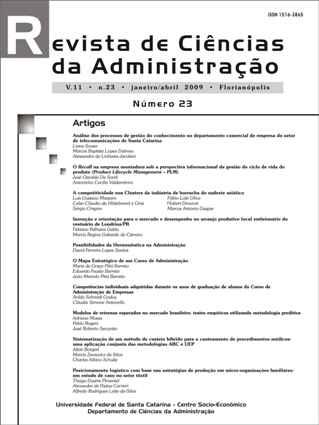Logistic positionning by prodution’s strategies in families micro-organizations: a case study on Textile Sector
DOI:
https://doi.org/10.5007/2175-8077.2009v11n23p245Abstract
The strategies of logistic positioning are analyzed, emphasizing that relative to the production and management of operations, in family micron-organizations. One became fullfilled a revision on logistic positioning, strategies of production and operations to base the case of an inserted family organization on the context of the Feira Hippie of Belo Horizonte /MG. The qualitative research was based on the research-action having aimed at to identify, next to the family manager, the strategies of logistic positioning, production and management of adopted operations face to its productive context. It was observed as the family micro-organizations adopt internal strategies (tacit/emergent) and external (development of social nets), that they guarantee economic viability even so to them transfer costs to the suppliersDownloads
Published
How to Cite
Issue
Section
License
The author must ensure:
- that there is complete consensus among all co-authors to approve the final version of the paper and its submission for publication.
- that their work is original, and if the work and/or words of others have been used, these have been duly acknowledged.
Plagiarism in all its forms constitutes unethical publishing behavior and is unacceptable. RCA reserves the right to use software or any other methods of plagiarism detection.
All submissions received for evaluation in the RCA journal are screened for plagiarism and self-plagiarism. Plagiarism identified in manuscripts during the evaluation process will result in the submission being archived. In the event of plagiarism being identified in a manuscript published in the journal, the Editor-in-Chief will conduct a preliminary investigation and, if necessary, retract it.
Authors grant RCA exclusive rights of first publication, with the work simultaneously licensed under the Creative Commons (CC BY) 4.0 International License.

Authors are authorized to enter into separate, additional contractual arrangements for the non-exclusive distribution of the version of the work published in this journal (e.g., publishing in an institutional repository, on a personal website, publishing a translation, or as a chapter in a book), with an acknowledgement of its authorship and initial publication in this journal.
This license grants any user the right to:
Share – copy, download, print, or redistribute the material in any medium or format.
Adapt – remix, transform, and build upon the material for any purpose, even commercially.
According to the following terms:
Attribution – You must give appropriate credit (cite and reference), provide a link to the license, and indicate if changes were made. You may do so in any reasonable manner, but not in any way that suggests the licensor endorses you or your use.
No additional restrictions – You may not apply legal terms or technological measures that legally restrict others from doing anything the license permits.


